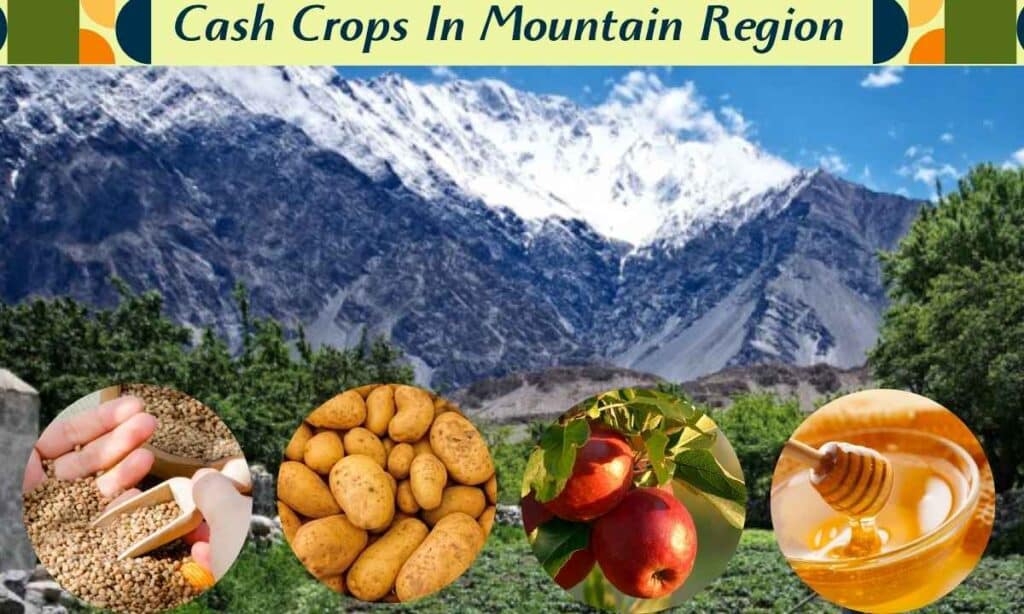If you are Nepalese, you must know what crops and products you mostly serve daily. These mostly served crops are main crops while there are some cash crops you don’t know but are economically beneficial for farmers and the nation. Nestled within the picturesque landscapes of the Himalayas, Nepal boasts an agricultural heritage as diverse as its natural beauty. Blessed with fertile plains, gentle hills, and soaring mountains, this small South Asian nation is home to a remarkable array of cash crops that have played a vital role in shaping its economy and sustaining livelihoods for generations.
In this blog, we will delve into the fascinating world of cash crops in Nepal, exploring their significant role in the country’s agricultural sector, their impact on the local economy, and the incredible opportunities they offer to farmers and entrepreneurs alike. Whether you have a keen interest in agriculture, are an aspiring entrepreneur, or are simply curious about the agricultural landscape of Nepal, this blog will provide valuable insights into the vibrant world of cash crops.
What are Cash Crops
Cash crops are agricultural crops that are primarily grown and cultivated for the purpose of generating income and profit. Unlike subsistence crops, which are mainly produced for personal consumption, cash crops are cultivated with the intention of selling them in local or international markets. These crops are typically selected based on their high market demand, profitability, and suitability for the local climate and soil conditions.
Cash crops can vary widely depending on the region and prevailing market conditions. They include staple food crops like rice, maize, and wheat, as well as horticultural crops such as fruits, vegetables, and spices. Additionally, cash crops can encompass commodities like coffee, tea, cocoa, cotton, tobacco, rubber, and oilseeds.
Cash Crops Of Nepal
Nepal’s favorable climate, varied topography, and abundant water resources create an ideal environment for cultivating an impressive array of cash crops. From the terraced fields of rice and maize in the plains to the slopes covered with tea and coffee plantations, the country’s agricultural landscape is a tapestry of colors and flavors.
1. Staple Crops: Rice and Maize
Rice and maize, as staple crops, have been the backbone of Nepal’s agriculture for centuries. With its vast paddy fields and fertile river basins, Nepal produces an abundance of rice, meeting a substantial portion of the country’s food demand. Similarly, maize cultivation not only caters to local consumption needs but also serves as a vital cash crop for farmers, generating income through domestic sales and exports.
2. Horticultural Delights: Fruits and Vegetables
Nepal’s diverse climate zones support the cultivation of an impressive variety of fruits and vegetables. From juicy oranges in the subtropical regions to succulent apples in the temperate highlands, and from crunchy cucumbers in the mid-hills to vibrant tomatoes in the plains, the horticultural sector is a flourishing domain in Nepal. These cash crops not only meet the local demand but also find their way into international markets, contributing significantly to the country’s export earnings.
What is Corporate Social Responsibility
3. Spices and Medicinal Plants
Nepal’s rich biodiversity offers a treasure trove of aromatic spices and medicinal plants. The country is renowned for its production of high-quality herbs such as cardamom, ginger, turmeric, and herbs like stevia and jatamansi. These cash crops not only serve as flavor enhancers and traditional remedies but also hold immense potential for global trade and the growing herbal medicine industry.
4. Tea, Coffee, and Cashews
Nepal’s rolling hills provide the perfect conditions for growing tea, coffee, and cashew nuts. Tea estates, predominantly in the eastern regions, produce a range of premium teas, including black, green, and white tea varieties. Similarly, coffee cultivation has gained momentum in recent years, with Nepali coffee gaining recognition for its unique flavors. Cashew nuts, too, have emerged as a lucrative cash crop, drawing attention from domestic and international markets.
5. Dairy and Livestock Products
Nepal’s rural communities heavily rely on dairy and livestock farming as a source of income. The country’s favorable climate and abundance of natural pastures provide an ideal environment for rearing cattle, buffaloes, goats, and sheep. Dairy products such as milk, ghee (clarified butter), and cheese contribute significantly to the local economy, while the export of livestock and their products presents a lucrative opportunity for international trade.
6. Floriculture
Nepal’s scenic beauty extends to its flourishing floriculture industry. The country’s temperate climate and fertile soil facilitate the cultivation of a wide variety of flowers, including roses, marigolds, lilies, and orchids. The vibrant floral industry supplies flowers for local consumption, religious ceremonies, and international markets. With increasing global demand for Nepali flowers, the floriculture sector holds immense potential for expansion and economic growth.
7. Sericulture
Silk production, or sericulture, has a long history in Nepal. The country’s diverse climate zones, particularly in the hills and mountains, support the growth of mulberry trees, which are essential for silk worm rearing. Sericulture offers a valuable source of income for rural communities, as the silk industry encompasses activities such as silk farming, silk reeling, spinning, weaving, and silk-based handicrafts. The high-quality silk produced in Nepal has gained recognition worldwide, providing an excellent opportunity for export-oriented businesses.
8. Oilseeds
Nepal’s favorable agro-climatic conditions support the cultivation of various oilseeds, including mustard, sunflower, sesame, and linseed. Oilseeds serve as an essential cash crop, providing edible oils for both domestic consumption and industrial purposes. With increasing demand for healthy cooking oils and potential for oilseed exports, the oilseed sector presents an attractive avenue for investment and entrepreneurship.
9. Sugarcane
Sugarcane cultivation holds a prominent place in Nepal’s agricultural landscape. The southern plains of the country, with their rich alluvial soil and warm climate, provide an ideal environment for growing sugarcane. The sugar industry plays a vital role in the local economy, generating employment opportunities and contributing to rural development. Additionally, Nepal’s sugarcane industry produces molasses and ethanol, further diversifying its revenue streams.
10. Barley
Barley (Hordeum vulgare) is an important cereal crop grown in various parts of Nepal, especially in the high-altitude regions. It is primarily cultivated for its grains, which have multiple uses. Barley is a versatile crop that can withstand harsh environmental conditions and is well-suited to the challenging terrains and cooler temperatures of Nepal’s mountainous regions.
How many languages are spoken in Nepal
Why is it important to identify Cash Crops
Identifying important cash crops is crucial for several reasons:
- Economic Impact: Cash crops play a significant role in the economy of a region or country. Identifying important cash crops helps in understanding the contribution of agriculture to the overall GDP and employment generation. It allows policymakers to develop targeted strategies to support and promote the cultivation, processing, and marketing of these crops, thereby boosting economic growth.
- Market Opportunities: Recognizing important cash crops enables farmers, entrepreneurs, and investors to capitalize on market opportunities. By understanding the demand and trends for specific crops, stakeholders can make informed decisions regarding cultivation, investment, and market entry. This helps in maximizing profits and optimizing resource allocation.
- Export Potential: Many cash crops have high export potential, contributing to foreign exchange earnings. Identifying important cash crops allows countries to focus on producing goods that have a competitive advantage in the international market. This helps in expanding export markets, reducing trade deficits, and enhancing the country’s economic resilience.
- Agricultural Sustainability: Identifying important cash crops helps in promoting sustainable agricultural practices. It allows policymakers and farmers to focus on crops that are well-suited to the local climate and soil conditions, reducing the reliance on water-intensive or environmentally detrimental crops. This promotes efficient resource utilization, soil conservation, and biodiversity preservation.
- Food Security: Cash crops are not only grown for commercial purposes but also contribute to the food security of a nation. Identifying important cash crops ensures a balanced approach to agricultural production, considering both staple food crops and cash crops. This helps in maintaining a stable food supply, reducing dependency on imports, and addressing food security concerns.
- Rural Development: Cash crops often provide income opportunities for rural communities. By identifying important cash crops, policymakers can design programs and initiatives to support smallholder farmers and enhance their productivity. This leads to poverty reduction, improved living standards, and overall rural development.
Major Cash Crops Grown In Hilly Region Of Nepal

The hilly region of Nepal is known for its unique agricultural practices and the cultivation of various cash crops suited to its specific climate and topography. Some of the cash crops grown in the hilly region of Nepal include:
- Tea: The hilly terrain provides an ideal environment for tea cultivation. Areas like Ilam, Dhankuta, and Kaski are renowned for their tea plantations. Nepali tea, known for its distinct flavor and aroma, has gained recognition in international markets, offering significant export potential.
- Coffee: The hilly regions of Nepal, such as Gulmi, Palpa, and Kaski, have been witnessing a growth in coffee cultivation. Coffee plantations thrive in moderate temperatures and suitable elevations of the hills. Nepali coffee is gaining popularity for its unique taste and quality, creating opportunities for domestic consumption and export.
- Cardamom: Cardamom is a high-value cash crop cultivated in the hilly regions of Nepal, particularly in Ilam, Taplejung, and Panchthar districts. The cool climate and adequate rainfall create favorable conditions for cardamom farming. Nepali cardamom is sought after for its distinct aroma and is in demand both locally and internationally.
- Ginger: Ginger cultivation is widespread in the hilly areas of Nepal. Places like Sindhupalchok, Dhading, and Gorkha are known for their ginger production. Nepali ginger is prized for its quality and flavor and is used both in domestic markets and for export purposes.
- Apples: The hilly regions, such as Mustang, Jumla, and Manang, are renowned for apple orchards. The cool temperatures and suitable elevation in these areas create ideal conditions for apple cultivation. Apples from these regions are known for their taste and quality, attracting both local and international buyers.
- Buckwheat: Buckwheat, a versatile crop, is commonly grown in the hilly regions of Nepal. It thrives in the cooler climates and is used for making traditional dishes like dhido and roti. Buckwheat cultivation provides a source of income for farmers in the hilly areas and serves as an important staple crop.
- Potatoes: Potatoes are a widely grown cash crop in the hilly regions of Nepal. The cool and moist climate of areas like Solu, Rasuwa, and Okhaldhunga is suitable for potato farming. Nepali potatoes are known for their taste and quality and contribute to both domestic consumption and commercial purposes.
These are just a few examples of the cash crops grown in the hilly region of Nepal. The unique climatic conditions and fertile soil of these areas offer opportunities for farmers to cultivate a diverse range of crops, contributing to the local economy and providing livelihoods for communities in the hilly regions.
Cash crops grown in Terai region of Nepal

The Terai region of Nepal, with its fertile plains and favorable climatic conditions, supports the cultivation of a wide range of cash crops. Here are some of the cash crops grown in the Terai region:
- Rice: The Terai region is known as the “granary of Nepal” due to its extensive paddy fields. Rice cultivation is the primary cash crop in the Terai, providing a staple food source for the country. The region produces various rice varieties, including Basmati and non-Basmati rice, meeting both domestic consumption and export demands.
- Maize: Maize is another important cash crop grown in the Terai. The warm climate and fertile soil make it an ideal region for maize cultivation. Maize is used for both animal feed and human consumption, and its by-products, such as corn oil and cornstarch, have commercial value.
- Sugarcane: The Terai’s alluvial plains offer suitable conditions for sugarcane cultivation. Sugarcane is a major cash crop in this region, supporting the sugar industry. Farmers cultivate sugarcane for its juice, which is processed into sugar, molasses, and ethanol. The sugarcane industry plays a significant role in the local economy and provides employment opportunities.
- Wheat: Wheat is grown in the Terai during the winter season when temperatures are cooler. The region produces a significant portion of Nepal’s wheat, which is used for both domestic consumption and seed production. Wheat cultivation provides income opportunities for farmers and contributes to food security.
- Mustard: Mustard is a commonly grown oilseed crop in the Terai region. The warm climate and fertile soil create favorable conditions for mustard cultivation. Mustard seeds are used for oil extraction, which is widely used in cooking and the production of various food products. Mustard cultivation offers income diversification for farmers.
- Vegetables: The Terai region is a major source of vegetable production in Nepal. Farmers grow a variety of vegetables, including tomatoes, cucumbers, cauliflower, cabbage, beans, and peppers. These vegetables cater to both domestic consumption and supply to urban markets.
- Fruits: The Terai’s favorable climate supports the cultivation of various fruits. Mangoes, bananas, guavas, papayas, and citrus fruits are among the commonly grown cash crops in the region. These fruits are not only consumed locally but also have potential for export.
- Oilseeds: Oilseeds such as mustard, sesame, and sunflower are cultivated in the Terai for oil extraction. These oilseeds contribute to edible oil production, both for domestic consumption and commercial purposes.
The Terai region’s agricultural productivity and the cultivation of these cash crops significantly contribute to Nepal’s economy, food security, and rural livelihoods. The region’s fertile plains and suitable climate offer immense opportunities for cash crop cultivation, making it an agricultural powerhouse in the country.
Cash crops grown in mountain region of nepal

The mountain region of Nepal is characterized by its rugged terrain and high-altitude areas, presenting unique challenges and opportunities for agriculture. Despite the harsh conditions, certain cash crops thrive in these mountainous regions, contributing to the local economy and livelihoods. Here are some cash crops grown in the mountain region of Nepal:
- Buckwheat: Buckwheat is a resilient cash crop that adapts well to the cooler temperatures and limited growing seasons of the mountains. It is a staple crop in many mountainous areas of Nepal and is used for making traditional dishes like dhido and roti.
- Potatoes: Potatoes are extensively cultivated in the mountain regions due to their adaptability to higher altitudes and cooler climates. They serve as an important cash crop for farmers, providing income opportunities and contributing to food security.
- Apples: Some mountainous areas of Nepal, such as Mustang, Jumla, and Manang, have favorable conditions for apple orchards. The cooler temperatures and suitable elevation support apple cultivation, and the region produces high-quality apples that are in demand both locally and for export.
- Kiwifruit: Kiwifruit cultivation has gained popularity in certain mountain regions of Nepal, such as Ilam and Panchthar. The favorable altitude and climatic conditions make these areas suitable for growing kiwifruit, offering an alternative cash crop for farmers.
- Honey: Beekeeping and honey production are important income-generating activities in the mountain regions of Nepal. The diverse flora and clean mountain environment contribute to the production of high-quality honey, which has both domestic and export markets.
- Medicinal Herbs: The mountain regions of Nepal are rich in biodiversity and host a variety of medicinal herbs. These herbs, such as yarsagumba (Cordyceps sinensis) and jatamansi (Nardostachys jatamansi), have significant commercial value and are harvested for their medicinal properties.
- Tea: In select mountainous areas, tea cultivation has been successfully introduced. Although it requires specific microclimates and careful cultivation, tea plantations have been established in regions like Ilam and Dhankuta, producing high-quality tea leaves.
These cash crops provide income diversification for farmers in the mountain regions, contribute to the local economy, and offer opportunities for agro-tourism. The cultivation of these crops showcases the resilience and adaptability of farmers in the face of challenging terrains and harsh climatic conditions.
Conclusion
The main crops of Nepal encompass a diverse range of cash crops. These cash crops of Nepal include rice, maize, wheat, sugarcane, tea, coffee, cardamom, ginger, apples, mustard, vegetables, fruits, and oilseeds. Cultivating these crops contributes to economic growth, employment generation, export potential, agricultural sustainability, and food security. Nepal’s focus on these main cash crops drives rural development and enhances the overall economy.
FAQs
What are the main cash crops grown in Nepal?
The main cash crops grown in Nepal include rice, maize, wheat, sugarcane, tea, coffee, cardamom, ginger, apples, mustard, vegetables, fruits, and oilseeds.
Which region of Nepal is known for cash crop cultivation?
The Terai region of Nepal is renowned for its extensive cash crop cultivation due to its fertile plains and favorable climatic conditions.
What are the cash crops grown in the hilly region of Nepal?
Cash crops grown in the hilly region of Nepal include tea, coffee, cardamom, ginger, apples, buckwheat, and potatoes, taking advantage of the unique climate and topography.
What are the challenges faced in cultivating cash crops in the mountain region of Nepal?
Cultivating cash crops in the mountain region of Nepal presents challenges such as harsh weather conditions, limited growing seasons, difficult terrains, and the need for specific adaptations and techniques.
Are there any high-value cash crops grown in Nepal?
Yes, Nepal cultivates high-value cash crops such as tea, coffee, cardamom, apples, kiwifruit, and medicinal herbs, which have significant commercial value and offer income opportunities for farmers.
